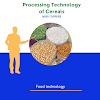PARBOILING OF RICE
INTRODUCTION, PROCEDURE, ADVANTAGES & DIS ADVANTAGES
INTRODUCTION
The technique for parboiling of rice was developed in India to prevent losses occurring due to breakage during hand pounding, especially the long grained varieties. In this technique paddy is soaked in excess water and later on cooked in its husk, the objective being pregelatinizing the starch. Any hairline cracks are sealed due to homogeneous mass of gelatinized starch and thus prevent breakage during milling. The paddy is then drained and dried.
Parboiling can be accomplished in variety of ways. The general scheme is to hydrate (steeping) paddy to 32 – 38% moisture and partially gelatinize the starch by steam heating at 15 lb. pressure for 10 – 20 min.
Parboiling causes certain physico-chemical changes such as improved milling yields (66 – 70%), increased resistance to insects and firmer cooked rice texture accompanied by a darker and more yellow endosperm. Parboiling has further advantages like: during soaking and cooking the water-soluble vitamins (niacin, riboflavin, and thiamine) which are present in germ and pericarp gets migrated into endosperm and thus improves the nutritional value of parboiled rice. Even proteins present on the grain surface are denatured, become insoluble, and therefore are not removed during washing and cooking.
CFTRI PARBOILING PROCESS (Central Food Technology Research Institute, Mysore)
This was developed to avoid bad smell. The paddy is soaked in hot water (65-70°C). Germ action does not occur in hot water, thus the smell is avoided. Soaking time is reduced to 3-4 hrs.
The CFTRI also developed the pressure parboiling method. Soaking time is only 30-60 minutes and steam is passed through the grain to raise the pressure slowly from an initial 0.28-0.70kg/cm2 to 1.41-2.11 kg/cm2 and this is maintained for 20-30 min. In this method, the processing
time is reduced.
PPRC PARBOILING PROCESS (Paddy Processing Research Centre, Thanjavur)
It is also known as chromate soaking process. Chromate at the rate of 50g/100 kg paddy is added to the soaking water which stops germ action and eliminates bad smell.
A high temperature short time process was also developed at the PPRC. Steeped paddy is parboiled and dried concurrently by applying high temperature for a short time. Steeped paddy is fed into sand roaster. The paddy gets completely and uniformly parboiled and its subsequent cooking time is less.
ADVANTAGES OF PARBOILING OF RICE
1. Reduced losses-Dehusking of parboiled rice is easy and the grain becomes tougher resulting in reduced losses during milling
2. Higher yield-Higher yield of head rice from milling because kernel is more resistant to breakage.
3. Reduced infection and infestation-Milled parboiled rice has greater resistance to insects and fungus infection.
4. Improved nutritive value-The nutritive value of rice increases after parboiling because the water dissolves the vitamins and minerals present in the hulls and bran coat and carries them into the endosperm. The water-soluble B vitamins, thiamine, riboflavin and niacin are higher in milled parboiled rice than in milled raw rice.
5. Better quality-Parboiled rice does not turn into a glutinous mass when cooked.
DISADVATAGES OF PARBOILING OF RICE
1. Flavour-It has a bad smell due to prolonged soaking.
2. Colour-It has a dark colour due to heat treatment.
3. Cooking time-It requires prolonged cooking time and more fuel.
4. Difficulty in polishing-Since the oil content is more, the polisher may get choked.
5. Keeping quality-The heat treatment may destroy antioxidants. Hence, rancidity may develop.
6. Safety-Due to the high moisture content, mycotoxins may be formed.
7. Cost-Drying cost is added to the total processing cost, extra capital investment.















0 Comments
Send feedback